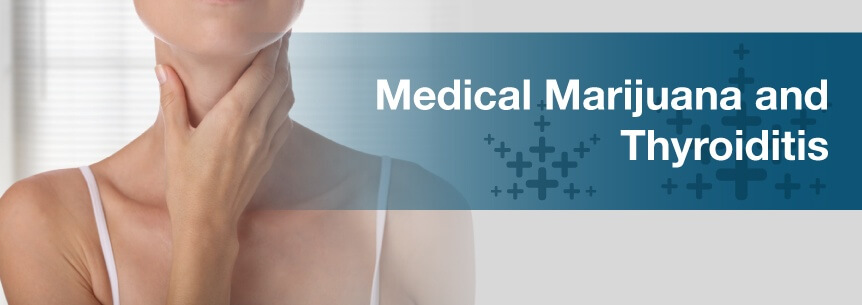
Since as early as 2,700 B.C., people have utilized marijuana’s medicinal properties. While often still stigmatized in today’s cultural climate, more and more researchers and physicians are acknowledging the extensive benefits of medical cannabis in treating a wide array of illnesses and disorders.
Fortunately, thyroiditis is no exception.
Encompassing several disorders, thyroiditis describes conditions that deal with the inflammation of the thyroid gland. Because it covers several disorders, a diagnosis of thyroiditis comes with a variety of different symptoms and prescribed medications. With all the options, understanding what treatments to pursue can be confusing.
We’ve compiled a guide to thyroiditis, as well as conventional treatments and cannabis alternatives. Medical marijuana can significantly alleviate both the core issues and the symptoms of thyroiditis, and it can improve your quality of life while dealing with these challenging disorders.
Marijuana has been used medicinally for millennia. The secret behind pot’s power is its cannabinoids, the naturally-occurring compounds produced by the marijuana plant.
Find A Doctor Find A Dispensary
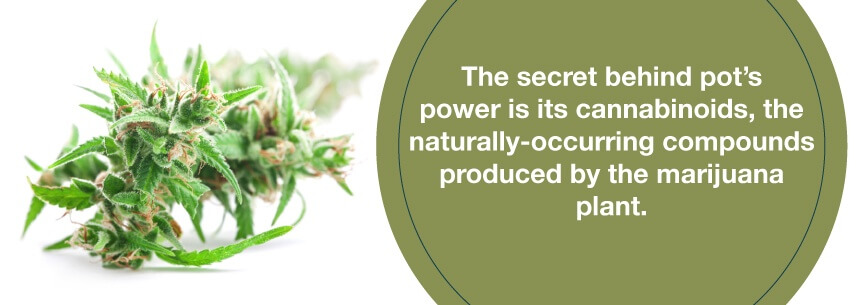
In our bodies, cannabinoids are received by our endogenous cannabinoid system. Located throughout the body, endocannabinoids and their receptors work to maintain homeostasis. Our bodies naturally produce some cannabinoids, and they fulfill a variety of essential functions, especially in minimizing pain and damage from injuries.
In marijuana, cannabinoids are categorized as either psychoactive or non-psychoactive. The major difference between the groups is that psychoactive cannabinoids lead to a high, and non-psychoactive cannabinoids don’t. For users seeking medicinal benefits, non-psychoactive cannabinoids offer the perfect compromise — healing benefits without a buzzed feeling.
Cannabidiol (CBD) is the most famous non-psychoactive cannabinoid. CBD is especially helpful concerning thyroid issues — because cannabinoids work within the body’s existing endocannabinoid system, CBD can directly affect the problem without interfering with other body systems.
Recent research shows that CBD’s thyroid potential is beginning to be noticed.
A 2002 study published in the European Journal of Endocrinology examined the effect of various cannabinoids on rat thyroids. Rats that received cannabinoids experienced a 30 percent decrease in hormone production, showing that cannabinoids can slow down thyroid hormone release. This is especially relevant for patients with hyperthyroid symptoms.
In 2009, a study published in the medical journal Endocrinology looked at the ability of CBD to activate hormone-synthesizing axons between the gland and the central nervous system. When examined together, the ramifications of these two studies are enormous. If these results are established through continued clinical trials, it will prove that CBD responds differently to the need of the patient — it can both suppress thyroid overactivity, and promote hormone release in underactive thyroids.
Besides being able to treat individual symptoms of thyroiditis, CBD has been shown to help the gland regulate itself, promoting full, long-term healing. But it also addresses common side effects, easing the discomfort of daily life.
Since every strain of marijuana has different effects, it’s important to choose the one that best suits your medical needs.
There are two major families of cannabis — indica and sativa. While indica has high levels of CBD, sativa is high with THC. For thyroid disorders, look for indica strains or indica-leaning hybrids, so you will be sure to receive large amounts of CBD.
Recommendations below should always be reviewed with a medical professional. A marijuana doctor will be best able to determine what strains are appropriate for your specific symptoms.
Many studies showcase the anti-inflammatory properties of cannabis, especially CBD. While both CBD and THC aid in reducing inflammation, a 2007 study showed that CBD in particular produces powerful anti-inflammatory and antioxidant effects.
Another test, conducted in 2008, studied mice with inflamed paws. Unsurprisingly, mice given a dose of cannabis experienced a 70 percent decrease in inflammation.
To deal with thyroiditis, we recommend the following strains for reducing inflammation:
The thyrotoxicosis phase of thyroiditis commonly results in increased anxiety, but cannabis can help alleviate the stress of this symptom.
While cannabis high in THC may promote anxiousness and paranoia, strains high in CBD increase relaxation and combat the effects of THC. When considering medical cannabis as a treatment for anxiety, be sure to consult with your marijuana doctor about strains low in THC and high in calming CBD.
The following strains can be helpful for reducing anxiety:
During the hyperthyroid symptoms of thyroiditis, patients can lose up to 10 pounds. Users often joke about the “munchies,” but in situations where weight loss is undesirable, the appetite-stimulating effects of some strains can be hugely beneficial.
We recommend trying some of the following cannabis strains to help you regulate metabolism:
Due to its relaxing effects, CBD is effective in treating insomnia. Without the hallucinogenic side effects of THC, you can enjoy increased drowsiness and peace without worrying about anxiety-inducing symptoms.
Useful strains for insomnia and restlessness include:
For people with severe thyroiditis, pain is part of daily life. It doesn’t have to be — medical cannabis has been used to treat pain for centuries. Complementing the endocannabinoid system, CBD promotes pain relieving responses throughout the body, and can significantly decrease discomfort.
For pain management, try these CBD-heavy strains:
Smoking a joint isn’t the only way to enjoy marijuana. Experiment with the many different ways to consume medical cannabis — each one creates its own unique experience. Below, we’ve explained the four most common methods for consuming cannabis — for a list of all the methods of marijuana consumption, read our comprehensive guide.
While it isn’t the only way to experience marijuana, smoking is the most popular and known. To smoke, a user places a small piece of cannabis, and either rolls it into a joint or puts it in a pipe or bong.
Smoking allows cannabis to affect a user almost immediately, and it is easy to control dosage at relatively low cost. However, if you have a lung or breathing condition, consider another method of method — smoking can potentially cause lung irritation.
Although vaping may resemble smoking, the forms are very different. In smoking, the chemical compounds of marijuana are released at a high temperature, and you inhale hot smoke into your lungs. Vaping releases the same chemicals at a lower temperature.
Because of the cooler temperature, vaped cannabis doesn’t have the burnt overtones of smoked marijuana. It is also safer on the lungs, protecting them from harsh smoke.
If you’re not a fan of brownies, don’t worry — you can ingest marijuana in many different forms, such as crackers, chocolate bars and lollipops. If the smell or taste of cannabis is off-putting to you, edibles provide a tasty alternative that gives all of weed’s potency and none of its scent.
Besides having a great taste, edibles allow you to control your dosage precisely. While the effects take longer to appear — 30 minutes to hours — they are typically stronger.
If you want the pain-relieving elements of marijuana without risk of a high, try topical solutions. Creams and lotions infused with cannabis provide quick relief, and you avoid the euphoric or hallucinogenic effects of some strains.
Topicals are very effective in treating localized pain and inflammation, but not for deeper internal issues. For thyroiditis, topical marijuana may be useful in treating discomfort around a swollen thyroid, but it won’t address the root cause of your disorder.
Before trying a cannabis strain, consult with a medical professional. While marijuana can be helpful in treating thyroiditis, some strains can agitate already-present symptoms like anxiety, insomnia, fatigue and increased heart rate.
Marijuana reacts differently for each person, so you might need to experiment a little to figure out the best strain for your thyroiditis and lifestyle. By experimenting under the supervision of a marijuana doctor, you minimize risks of adding more symptoms or complications and cut down on the trial-and-error period of finding the perfect strain.
To learn more about cannabis and thyroiditis, check out our database of medical cannabis dispensaries and find store locations, hours, reviews, shipping policies and more. Also, search our directory of medical marijuana doctors to find a professional in your area to help you treat your thyroiditis and begin your path to healing today.
Find A Doctor Find A Dispensary
Thyroiditis is a catch-all description for several individual illnesses concerning the inflammation of the thyroid. The thyroid is an essential hormone-secreting gland located in the middle of the neck, just under the Adam’s apple.
Weighing only one ounce, this butterfly-shaped gland makes hormones that regulate the body’s metabolic rate, which determines how fast your body processes food or produces heat. It also helps to pace your heart, ensuring a steady pulse.
If your thyroid is overactive, it produces more than enough hormones for normal body function. You can have surges of energy and experience racing heart rates. The resulting cell damage is rapid, raising thyroid hormone levels in the blood. These are considered thyrotoxic, or hyperthyroid, symptoms.
Alternatively, if your thyroid is underactive, it isn’t producing enough hormones. With an underactive thyroid, you’ll feel tired and lethargic — the damage is slow and chronic. These types of disorders are grouped under hypothyroidism.
Thyroiditis typically includes two phases: thyrotoxicosis, which has symptoms similar to hyperthyroidism, and hypothyroidism. Thyrotoxicosis occurs first and is usually the shorter phase. The hypothyroid phase can be long-lasting and even permanent. Because thyroiditis disorders have both phases, treatments must consider the effects of both an overactive and underactive thyroid.
The most common types of thyroiditis occur as an immune system malfunction. The body sends antibodies to attack the thyroid, leading to inflammation and damage of thyroid cells. Research is still unclear on what makes people produce these thyroid antibodies. They tend to run in families, but no linking gene has been identified.
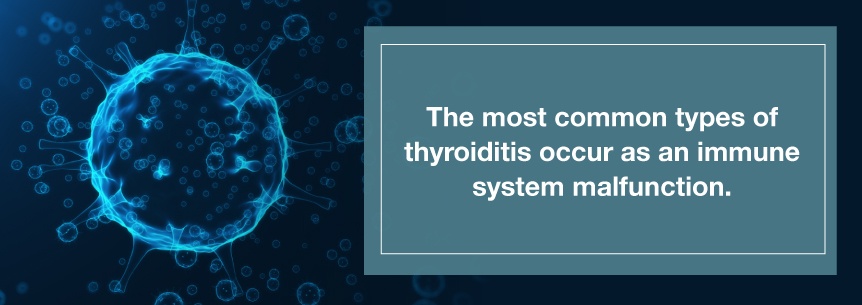
Besides immune failure, certain medical treatments can also result in thyroiditis. Drugs such as interferon and amiodarone often damage thyroid glands, leading to an inflammatory response.
Thyroiditis can also be caused by infections, which, like antibodies, attack the thyroid. The infection is caused by either viruses or bacteria, and the resulting thyroiditis is addressed by treating the infection.
Physicians recognize seven main types of thyroiditis, each with different causes and symptoms.
Discovered by physician Hakaru Hashimoto in 1912, Hashimoto’s thyroiditis is the most occurring type.
Also called autoimmune or chronic lymphocytic thyroiditis, this type evolves because of the presence of anti-thyroid antibodies in the bloodstream. Hashimoto’s is an autoimmune disease — the body attacks its own thyroid.
With Hashimoto’s, the thyroid becomes enlarged, and hormone production drops. In fact, Hashimoto’s thyroiditis is the most common cause of hypothyroidism in the United States. Most common in middle-aged women, Hashimoto’s thyroiditis typically results in permanent hypothyroidism and requires continual, life-long treatment.
Also called painless thyroiditis, silent thyroiditis comes from autoimmune failure, and has a strong initial phase of thyrotoxicosis. Because of similar symptoms, patients with silent thyroiditis were misdiagnosed with Graves’ disease until the 1970s.
Silent thyroiditis is the second most common form of thyroiditis after Hashimoto’s. Silent thyroiditis will generally resolve itself without treatment, but there remains a risk of permanent damage.
Post-partum thyroiditis is caused by autoimmune malfunction and shortly follows childbirth. In post-partum thyroiditis, the patient goes through the typical two phases — thyrotoxicosis before hypothyroidism.
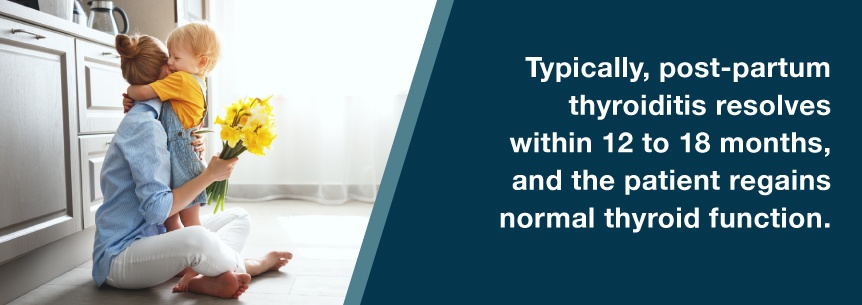
Typically, post-partum thyroiditis resolves within 12 to 18 months, and the patient regains normal thyroid function. However, there remains a 20 percent chance of post-partum thyroiditis resulting in permanent hypothyroidism.
Drug-induced thyroiditis does not come from an autoimmune disorder, but manifests as a side effect of several medical drugs. These thyroid-risking medications include amiodarone, lithium, interferons and cytokines.
Unlike other types, drug-induced thyroiditis manifests in either thyrotoxicosis or hypothyroidism, not both. Often, drug-induced thyroiditis lingers as long as the medication is taken, and resolves itself after treatment stops.
Like drug-induced thyroiditis, radiation-induced thyroiditis results from treatment with radioactive iodine or external beam radiation therapy. Radioactive iodine is typically prescribed for hyperthyroidism, and external beam radiation is reserved for certain cancers.
While radiation-induced thyroiditis can have a phase of thyrotoxicosis, it more frequently results in just hypothyroid symptoms. Often, radiation-induced thyroiditis will heal after the radioactive treatments stop. However, the hypothyroidism related to radiation is typically permanent.
Also called de Quervain’s thyroiditis, subacute thyroiditis follows the same clinical pattern of post-partum or painless types. However, subacute thyroiditis comes with thyroidal pain, especially during the first thyrotoxicosis stage. The thyroid swells rapidly and is painful to the touch, and this thyroiditis is often accompanied by a fever.
Research suggests that subacute thyroiditis may be caused by a virus, but scientists haven’t been able to identify a definite infectious agent. Most patients regain normal thyroid function within 12 to 18 months, but there is a 5 percent chance of retaining permanent hypothyroidism.
Acute or suppurative thyroiditis is directly caused by an infectious organism like bacteria. Compared to the other types of thyroiditis, acute thyroiditis is relatively rare. While the thyroid does swell, it is mostly painless.
Often, the symptoms of acute thyroiditis disappear once the infection is treated. In some cases, the infection will lead to more severe illnesses and thyroid malfunction.
Because thyroiditis includes a variety of different disorders, it comes with a variety of different symptoms. However, some side effects are common, whatever type of thyroiditis you have.
For the thyrotoxicosis phase, symptoms often resemble those of hyperthyroidism and include:
In the hypothyroid phase, patients with thyroiditis will often experience:
Whatever the form, living with thyroid disorders significantly impacts daily life.
Conventional treatments range from aspirin to thyroid removal surgery, and they are often dependent on the individual patient and the severity of their symptoms. We’ve grouped some of the most commonly prescribed treatments below:
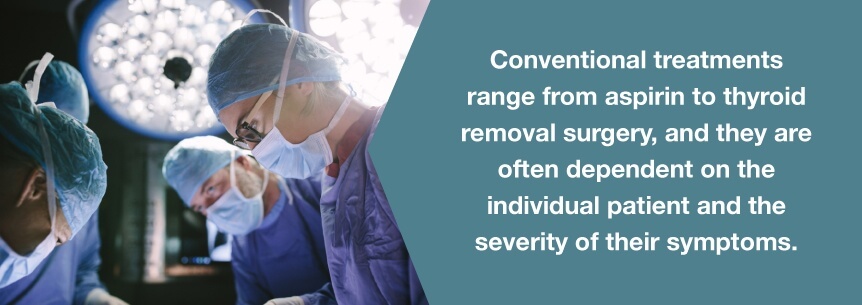
Side effects include:
Possible side effects include:
Side effects include:
For mild pain or inflammation, over-the-counter pain medications like Tylenol are often prescribed. On the other end of the spectrum, some severe cases of thyroiditis can result in thyroid removal surgery, which requires taking thyroid hormone replacement for the rest of your life.